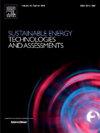用于综合能源系统多能源负荷预测的两阶段双关注时空联合网络模型
IF 7.1
2区 工程技术
Q1 ENERGY & FUELS
Sustainable Energy Technologies and Assessments
Pub Date : 2024-11-18
DOI:10.1016/j.seta.2024.104085
引用次数: 0
摘要
准确预测多能源负荷对综合能源系统的调度、安全运行和稳定性至关重要。本文针对综合能源系统提出了一种新型的两阶段多能源负荷预测模型,该模型采用双注意时空联合网络。在多任务预测的第一阶段,建立集成自注意长短期记忆(LSTM)网络对多能源负荷进行初始预测,并在 BP 网络的基础上构建误差修正模型,以减少误差积累对第二阶段预测的影响。在第二阶段的单任务预测中,提出了并行时空联合网络模型,提取多能源负荷之间以及负荷与气象要素之间的静态空间特征和动态时间特征,充分捕捉多能源负荷之间复杂的相互作用和依赖关系。预测模型在两个阶段都集成了自我关注和图关注机制,以提高特征提取能力。仿真结果表明,与双向 LSTM、LSTM 门控递归单元、时间卷积网络-LSTM 和变模分解-卷积神经网络-LSTM 模型相比,所提出的多能源负荷预测模型的平均绝对百分比误差分别降低了 66.25%、16.83%、53.58% 和 5.29%。本文章由计算机程序翻译,如有差异,请以英文原文为准。
Two-stage dual-attention spatiotemporal joint network model for multi-energy load prediction of integrated energy system
Accurate prediction of multi-energy load is essential for the scheduling, safe operation, and stability of integrated energy systems. This paper proposes a novel two-stage multi-energy load prediction model with dual-attention spatiotemporal joint network for integrated energy system. In the first stage of multi-task prediction, the integrated self-attention long short-term memory (LSTM) network is built to forecast the multi-energy load initially, and an error correction model on basis of BP network is constructed to reduce the impact of error accumulation on the second stage prediction. In the second stage of single-task prediction, a parallel spatiotemporal joint network model is proposed to extract the static spatial feature and dynamic temporal feature between multi-energy loads and between loads and meteorological factors, which fully captures the complex interactions and dependencies between the multi-energy loads. The prediction model integrates self-attention and graph attention mechanisms in both stages to improve the feature extraction capabilities. The simulation results demonstrate that, compared to bidirectional LSTM, LSTM-gated recurrent unit, time convolutional networks-LSTM and variational mode decomposition-convolutional neural network-LSTM models, the proposed multi-energy load prediction model reduces the average absolute percentage error by 66.25%, 16.83%, 53.58% and 5.29%, respectively.
求助全文
通过发布文献求助,成功后即可免费获取论文全文。
去求助
来源期刊

Sustainable Energy Technologies and Assessments
Energy-Renewable Energy, Sustainability and the Environment
CiteScore
12.70
自引率
12.50%
发文量
1091
期刊介绍:
Encouraging a transition to a sustainable energy future is imperative for our world. Technologies that enable this shift in various sectors like transportation, heating, and power systems are of utmost importance. Sustainable Energy Technologies and Assessments welcomes papers focusing on a range of aspects and levels of technological advancements in energy generation and utilization. The aim is to reduce the negative environmental impact associated with energy production and consumption, spanning from laboratory experiments to real-world applications in the commercial sector.
 求助内容:
求助内容: 应助结果提醒方式:
应助结果提醒方式:


